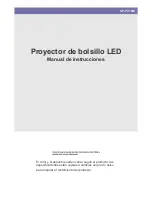
Commission on Lighting) was created in
1927, and in 1931 established a colorime-
try system to describe colors using a simple system of
numerical coordinates. I won’t delve into the details behind
that system other than to say it is based on the tristimulus
response principles discussed earlier and experiments that
were done with human observers. A result of their work
was the creation of a two-dimensional (x,y) chart called the
CIE Chromaticity Diagram. (Figure 3)
The CIE Chromaticity Diagram
The horseshoe-shaped curve in the diagram is called the
Spectral Locus, and consists of all colors with only a single
wavelength. The lowest wavelength color, ultraviolet at 380
nm, is located at the bottom left of the horseshoe, and the
wavelengths increase moving around the Spectral Locus to
infra-red, at 780 nm, on the far right. The Line of Purples
connecting the ends of the locus represents colors that can-
not be created with any single wavelength.
The line shown in the middle is the called the Plankton
Locus, or blackbody radiation curve. The color temperature
is infinite at the left end and drops to several thousand
degrees as the Plankton Locus converges with Spectral
Locus in the reds. The important D65 white reference, at a
correlated color temperature of 6500K, is at (0.3127, 0.329)
expressed as CIE (x,y) coordinates. It is a “correlated” color
temperature because it lies just off the Plankton Locus.
Brightness is not shown on the diagram, only saturation
and hue. The hue of totally pure colors is determined by
their position on the Spectral Locus, or Line of Purples. The
saturation is determined by how far the color lies from the
reference white point near the center of the diagram. The
pastel colors lie close to the center and the pure, fully satu-
rated colors lie on the horseshoe.
5. Display Color Accuracy
RGB Primaries – The Color Triangle
One of the properties of the CIE diagram is that any color
created by mixing two other colors will
lie on a straight line connecting them.
The distance along the line where the new color appears is
inversely related to the proportions of the two colors. Since
all single-wavelength visible colors lie on the Spectral
Locus, all visible colors must be inside the locus. Further-
more, it follows that all colors made from a combination of
three primary colors must lie inside a triangle formed by the
three colors. Colors outside the triangle cannot be repro-
duced because that would require negative amounts of light
from one or two primaries.
The red, green, and blue primaries of video systems are
chosen to enclose a reasonably large triangle that deter-
mines the entire gamut of colors that can be displayed. If
two displays have slightly different sets of red, green, and
blue primaries, the overlapping color triangles demonstrate
that the two displays cannot produce exactly the same
gamut of colors. (Figure 4)
Equally important, since the primaries are at different
locations, mixing the primaries with the same proportions
of light will generate different colors. Hence we see that to
reproduce the colors specified by video signals, it is critical
that the primaries be matched to the video system stan-
dards.
The NTSC primaries were specified in 1953 based on
phosphors available at that time. But over the years, TV dis-
play manufacturers continually used newer phosphors that
provided higher light output than the original NTSC phos-
phors. This created serious color errors. Finally, in 1971 a
new set of primary phosphors, called the SMPTE “C” phos-
phors were selected. (The SMPTE C phosphor specification
has been revised since then with very slight changes.)
These are the phosphors used in all professional broadcast
monitors. Unfortunately, consumer CRTs are still using
slightly different phosphors, and different phosphors from
one product to another. (The SMPTE C phosphor values are
given in Table 1.)
The obvious result of not using the standard phosphors
V I D E O
Fig. 3
Fig. 4
















































